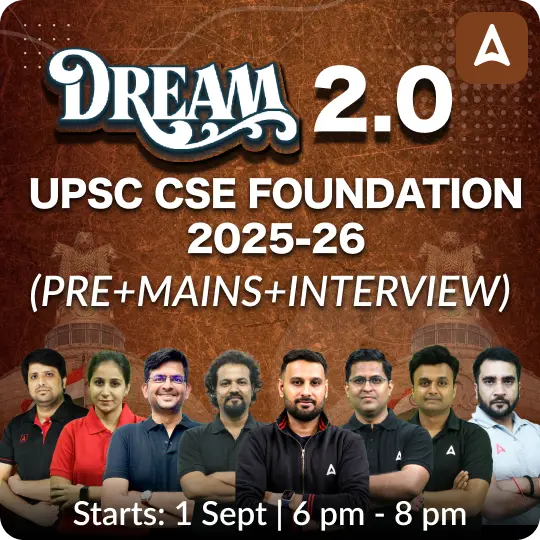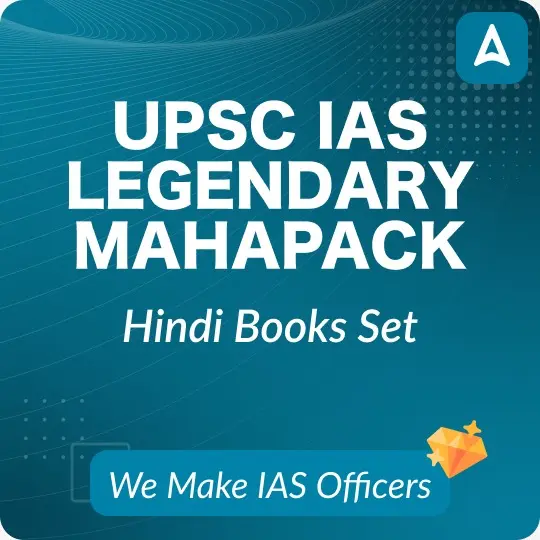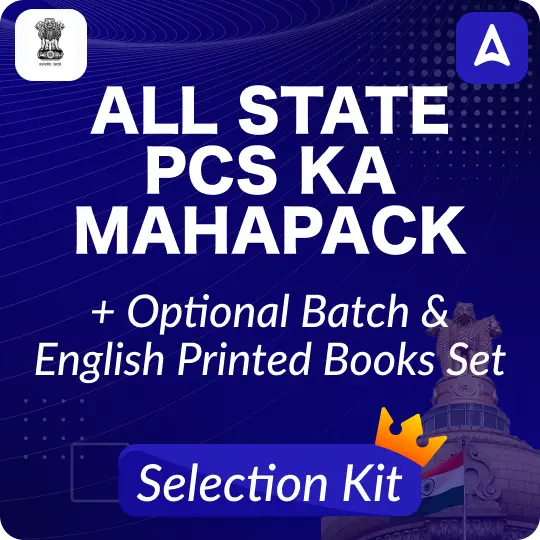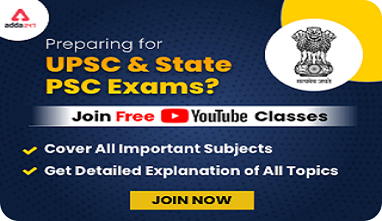Table of Contents
The Karnataka Public Service Commission (KPSC) will conduct the Karnataka Administrative Services (KAS) Prelims Exam 2024 on 29 December 2024 across various centers in Karnataka. This article provides the KPSC KAS Question Paper 2024, for both Paper I and Paper II. These question papers are helpful for candidates, and provide details of the exam pattern, difficulty level, important areas, and topic weightage.
KPSC Prelims General Studies Question Paper
The Karnataka Administrative Service (KAS) Exam, also called the Gazetted Probationers Exam, recruits candidates for Group A and Group B positions in the state’s executive branch. The KPSC KAS exam has two papers, each worth 200 marks, and is conducted offline. The questions are objective type, with each correct answer earning 2 marks. However, there is a negative marking of 0.25 marks for each incorrect answer.
KPSC KAS Question Paper 2024
The KPSC KAS Prelims 2024 is a screening test for selecting candidates for the Main Exam. The General Studies (GS) Paper 1 and Paper 2 were held in two shifts: 10 a.m. to 12 p.m. and 2 p.m. to 4 p.m. Each paper was worth 200 marks and lasted 2 hours. Below is a summary table of the KPSC Question Paper 2024 for both GS Paper 1 and GS Paper 2.
| KPSC Prelims Exam 2024- Highlights | |
|---|---|
| Name of the Exam | KPSC KAS CSE Prelims Exam 2024 |
| UPSC Prelims Question Paper 2024 | Released |
| Exam Type | Offline mode |
| Medium of Exam | English and Kanada |
| Mode of Questions | Multiple Choice Questions (MCQs) |
| Number of Questions | GS 1: 100 Questions GS 2: 100 Questions |
| Negative marking | GS 1: 0.25 GS 2: 0.25 |
| Duration of the Exam | 2 hours for each paper |
| Official Website | https://kpsc.kar.nic.in/ |
KPSC Prelims GS Question Papers PDF
You can now download the KPSC KAS Prelims GS for both papers available below in the table. The papers are provided for you to access and download, allowing you to review the questions and analyze the paper. Check it out
| KPSC KAS Question paper 2024 | |
| General Studies I | Download Now |
| General Studies II | Download Now |
In the KPSC KAS Question Paper 2024 of GS Paper 1 includes questions about various subjects such as Polity, Economy, Modern History and Current Affairs. Therefore, candidates need to prepare extensively for a wide-ranging syllabus.
From feedback, we will prepare an analysis of the KPSC Prelims GS Paper 1 and Paper 2 question paper 2024. Candidates can view the detailed subject-wise KPSC 2024 question paper Analysis below(In 29 December 2024).
History
- Madam Bhikaji Cama
Madam Bhikaji Cama was a prominent freedom fighter and one of the earliest leaders of the Indian independence movement. Born in 1861, she is known for raising the first version of the Indian national flag in 1907 in Stuttgart, Germany. She also worked with other freedom fighters like Lala Lajpat Rai and was a key figure in promoting the cause of Indian independence abroad. - Lahore Resolution (1940)
The Lahore Resolution, passed at the All-India Muslim League’s annual session in Lahore in 1940, called for the creation of an independent state for Muslims in the north-western and eastern zones of India. This laid the foundation for the creation of Pakistan in 1947. - Mina Bazar (Humayun, Akbar, Shah Jahan)
The Mina Bazar was a special market or event, often associated with the Mughal courts. It refers to royal fairs held during the reigns of emperors like Humayun, Akbar, and Shah Jahan. These were spaces for social gatherings, exhibitions, and trade, symbolizing the grandeur of the Mughal empire. - Morley-Minto Reforms (1909)
The Morley-Minto Reforms were introduced by the British government in 1909 to address political demands in India. They included the introduction of separate electorates for Muslims and allowed a limited degree of self-government. This reform is significant for its role in deepening the divide between Hindus and Muslims in the political arena. - Shivaji
Shivaji Maharaj was a Maratha king who founded the Maratha Empire in western India. Born in 1630, he is known for his military genius, progressive administration, and establishment of a strong navy. His reign marked a significant resistance to Mughal expansion in India. - Political Economy of Indirect Rule in Mysore (1881-1971)
The term refers to the system of governance and economic control in Mysore under British colonial rule. Indirect rule often meant that local rulers, like the Wodeyars of Mysore, were kept in place but operated under British oversight. The political and economic systems were structured to benefit British interests, particularly in trade, taxes, and military service. - Nagar Revolt
This refers to a revolt in the Nagar region of India, although specific historical context is unclear from the term alone. It could refer to a localized revolt or peasant resistance in a particular region. - Ajanta Paintings
The Ajanta Caves, located in Maharashtra, are famous for their ancient Buddhist paintings and sculptures. These date back to around 2nd century BCE to 6th century CE. The paintings depict the life of the Buddha and are considered masterpieces of Indian art. - Raja Ram Mohan Roy
Raja Ram Mohan Roy was a social reformer in the 19th century and is regarded as the father of the Indian Renaissance. He played a pivotal role in abolishing the practice of Sati and promoting modern education, social reforms, and the spread of the idea of rationalism. - Rummindei Inscription
The Rummindei Inscription is an edict of Emperor Ashoka, found in Lumbini, Nepal. It marks the spot where Queen Maya gave birth to Siddhartha Gautama, who would later become the Buddha. This inscription is significant for its reference to Ashoka’s support of Buddhism.
Polity
- Indian Statutory Commission (Simon Commission)
The Indian Statutory Commission, also known as the Simon Commission, was set up in 1927 by the British government to review constitutional reforms in India. It was boycotted by Indians because it did not include any Indian members. - Article 164(1A)
Article 164(1A) of the Indian Constitution deals with the appointment of the Chief Minister and the council of ministers in a state. It allows the Governor to appoint a Chief Minister and other ministers to aid and advise the Governor. - Article 38(1-2)
Article 38(1) and (2) of the Indian Constitution talk about the State’s duty to promote the welfare of the people by securing a social order based on justice. It directs the State to work towards minimizing inequalities in income and wealth. - Article 270
Article 270 of the Indian Constitution deals with the distribution of taxes between the Union and States. It defines how taxes collected by the Union Government are shared with the States. - Classical Language of Union Cabinet
The classical languages of India, such as Tamil, Telugu, Kannada, and Sanskrit, are officially recognized by the Union Government. The Union Cabinet uses English and Hindi as the primary languages of communication. - Impeachment of the President
The President of India can be impeached for violation of the Constitution under Article 61. The process involves both Houses of Parliament and requires a two-thirds majority in each House. - Bill Lapses When?
A Bill lapses when Parliament is prorogued or when the House is dissolved. However, a Bill does not lapse if it is in the Rajya Sabha and is pending consideration. - All Three Lists
The Constitution of India divides subjects into three lists: the Union List, the State List, and the Concurrent List, found in the Seventh Schedule. The Union List covers subjects on which only the central government can legislate, the State List pertains to state-level matters, and the Concurrent List includes subjects on which both the Union and State Governments can legislate.
Geography
- Moyar River
The Moyar River is a river in the southern part of India, flowing through the Nilgiri Hills in Tamil Nadu. It is part of the Cauvery river basin. - Palar River
The Palar River originates in the Nandi Hills of Karnataka and flows through Tamil Nadu. It is an important river for irrigation but is intermittent in flow. - Atmosphere Layers
The Earth’s atmosphere consists of five primary layers: the Troposphere (weather occurs here), Stratosphere (contains the ozone layer), Mesosphere (meteors burn up here), Thermosphere (auroras occur), and Exosphere (where the atmosphere fades into space). - Karst Topography
Karst topography is formed by the dissolution of soluble bedrock (like limestone). Features include caves, sinkholes, and limestone pillars, and it is common in areas with high rainfall and limestone bedrock. - Landforms Formed by Wind Deposition
Wind can create various landforms through deposition, such as dunes, sand sheets, and loess (wind-blown silt). Deserts often feature these wind-driven formations. - Cold Currents
Cold ocean currents originate from polar regions and move towards the equator. Examples include the California Current and the Canary Current. They can influence coastal climates and reduce temperatures. - Iran Borders
Iran shares borders with several countries: Turkey, Iraq, Afghanistan, Pakistan, Armenia, Azerbaijan, and Turkmenistan. It has a strategic location in the Middle East. - Wildlife Sanctuary
A wildlife sanctuary is a protected area where wildlife and plants are conserved. India has many such sanctuaries, like Jim Corbett, Sundarbans, and Kaziranga, which aim to protect biodiversity.
Science
- Quantum Mechanics
Quantum mechanics is the branch of physics that deals with phenomena at microscopic scales, such as atoms and subatomic particles. It introduces concepts like wave-particle duality, uncertainty principle, and quantum entanglement.
Economics
- GDP (Gross Domestic Product)
GDP is the total value of all goods and services produced within a country over a specific period. It is a key indicator of a country’s economic health. - Inflation
Inflation is the rate at which the general level of prices for goods and services rises, leading to a decrease in purchasing power. Central banks control inflation by adjusting interest rates. - Bank Rate
The bank rate is the rate at which a nation’s central bank lends money to commercial banks. It is used as a tool to control money supply and interest rates in the economy.
Current Affairs
- Chip 4 or Fab 4 Alliance
The “Chip 4” alliance, or “Fab 4,” is a grouping of the US, Japan, South Korea, and Taiwan, aimed at ensuring the security of semiconductor supply chains and reducing dependency on China for chips. - Djibouti Code of Conduct
The Djibouti Code of Conduct is an agreement between countries in the Horn of Africa to combat piracy and maritime crime in the region. - NITI Aayog
NITI Aayog is the National Institution for Transforming India. It is a policy think tank that replaced the Planning Commission, focusing on sustainable and inclusive development. - Blue Helmet in UN
Blue Helmets are the name given to United Nations peacekeeping forces. They are deployed in conflict zones to maintain peace and security. - Golan Heights and Abyei Border
The Golan Heights is a strategic plateau captured by Israel from Syria
How to Calculate Marks in KPSC KAS Prelims?
The exam consists of 100 objective-type questions, with each correct answer candidates will get 2 marks. However, there is also a negative marking system, where 0.25 marks are subtracted for each incorrect answer. The total duration of the exam is 2 hours.
| KPSC KAS Question Paper Marking |
Calculation: Total Marks for Correct Answers:
Negative Marking: If you answer a question incorrectly, you lose 0.25 marks.
Let us assume you answer 70 questions correctly and 30 questions incorrectly: Correct answers: 70×2=140 Total score: 140−7.5=132.5 marks |
KPSC KAS Previous year Question Paper
Below are the cancelled KPSC KAS question paper which was held on 27 August 2024. check it out
| KPSC KAS Previous Year Question Papers: Download the PDF | |
| KPSC KAS prelims Paper 2(27Aug) | Click Here |
| KPSC KAS prelims Paper 1(27 Aug) | Click Here |
| KPSC KAS Related Articles | |
| KPSC Exam PYQ | KPSC Hall Ticket |
| KPSC Syllabus 2024 | KPSC KAS Exam date |
| KPSC KAS Question Paper | KPSC KAS Exam Analysis |



 TSPSC Group 1 Question Paper 2024, Downl...
TSPSC Group 1 Question Paper 2024, Downl...
 TSPSC Group 1 Answer key 2024 Out, Downl...
TSPSC Group 1 Answer key 2024 Out, Downl...
 UPSC Prelims 2024 Question Paper, Downlo...
UPSC Prelims 2024 Question Paper, Downlo...







